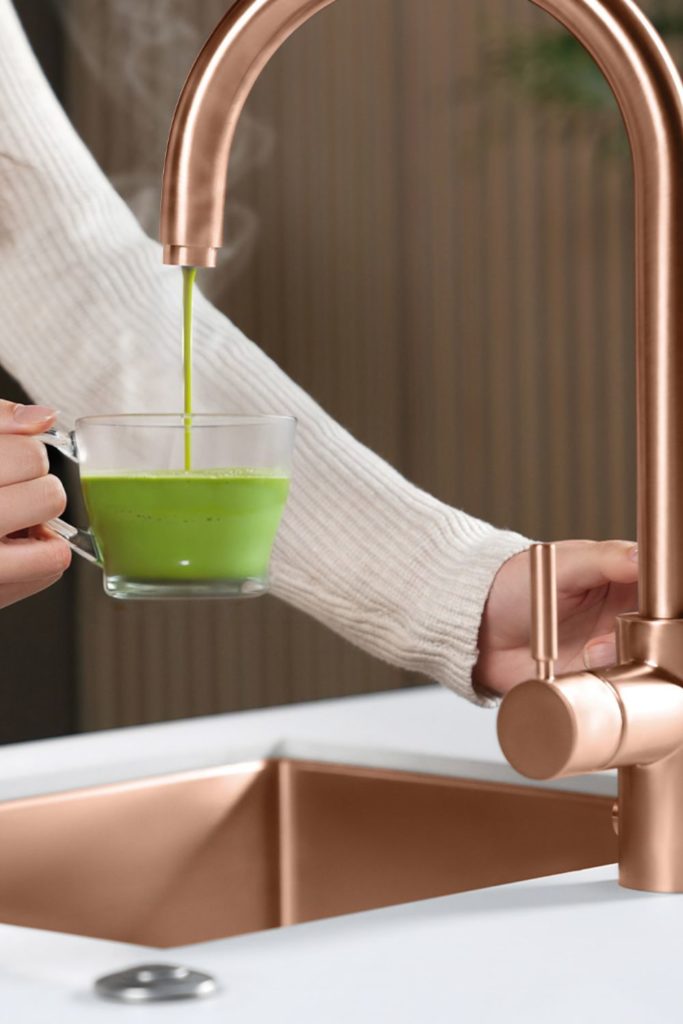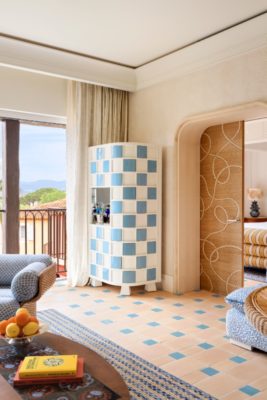The Key To Perfect Parisian Interiors, According To The Emily In Paris Set Designer
By
7 months ago
Anne Seibel, the show's Emmy-nominated set designer, tells all

While fashion is certainly at the heart of Emily in Paris, the show also flaunts some rather show-stopping interiors, from Emily’s bohemian bedroom to the picture-perfect offices of Agence Grateau. Wondering how, exactly, this Parisian dreamland came to life (and how you can recreate it)? Martha Davies sat down with the show’s set designer, Anne Seibel, to find out.
The Emily In Paris Set Designer Reveals The Key To Nailing Parisian Interiors
Hi Anne! Can you talk us through the key spaces in the show?
The main set I started with was Emily’s apartment. It’s a chambre de bonne: a very small room at the top of a building which used to serve as staff quarters. I decided to take this and create an apartment using two small rooms put together – so it’s small, but not too small to shoot in. And the idea was that, when Emily comes to Paris, the space is already furnished by people who live there, so it’s Parisian in style. We designed the interiors using vintage pieces and eclectic furniture.
Another important set is the Agence Grateau office, which all started with a brief explaining that I wanted to use Parisian architecture – Hausmannian architecture specifically – and transform one big apartment into an office. We kept all of the main features of a typical apartment: the fireplace, the wall moulding, the dado rails and the ceiling roses, alongside the wooden floors and French windows. Usually in this kind of space you have a big mirror over the fireplace, but we added a painting instead, and in the conference room we used a huge statement mirror.
Everything else in the office was designed according to the script and what was required – a reception space, a coffee area, all of the different offices – and I started with illustrations, floorplans and then 3D models.

Lily Collins as Emily, Samuel Arnold as Julien in episode 308 of Emily in Paris. Cr. Marie Etchegoyen/Netflix © 2022
Did you pull together a moodboard?
We definitely paid attention to the overall colour palette of these spaces – it’s not pastel but it’s not too bright. So, in the office, the conference room is blue but it’s not too vibrant. In terms of furniture, we used a mixture of antique and modern: in the reception area, for example, we took an old sofa and covered it with pink velvet. The entire space has kind of a DIY feel with some unique pieces – we copied a table we saw and made it ourselves, for example. We wanted it to look natural, replicating that gut feeling you get when you see pieces you like and put them together in a room.
Fashion is, of course, a huge part of the show. Was there a crossover between the fashion and set design?
We worked very closely with Marylin Fitoussi (the costume designer) to make sure that the interiors weren’t clashing with the outfits. My set was a bit of a jewllery box for Emily, with a lot of clothing on show, but we made sure that the interiors didn’t stand out too much since the clothes are quite eccentric. There’s a big clothes rail in Emily’s apartment – fashion is in the room, but as a prop. I have a very close relationship with Marylin and she gave us a lot of clothes to put in the set so it really felt lived in. But when the characters enter this environment, the clothes really pop because of the neutral, beige colours we used on the walls.
Can you give us some tips on recreating the Emily in Paris interiors at home?
I think architectural influences are important, and pattern, too. I don’t know quite how to explain the French aesthetic; you have elegance, but you also have bohemian style. You’ll go to the flea market, you know, or use antiques – in my own home, for example, I have furniture I’ve inherited from my mother and grandmother, but I’ve mixed them with more contemporary sofas and tables. It might be really historical furniture – Louis XVI for example – which you put together with contemporary sculptures or mirrors.
If you could choose one prop to take home, what would it be?
I always take things home! We’re still running for now so I can’t yet, but we always do a sale at the end, which is nice. I watched the new season yesterday in Rome and there’s a stool on one of the sets that I actually bought at the end, so I have it in my bedroom!

Lily Collins as Emily, Ashley Park as Mindy in episode 307 of Emily in Paris. Cr. Courtesy of Netflix © 2022
Anne Seibel’s Guide To Perfect Parisian Interiors
Think ‘Bourgeois Boho’
The key to Parisian style is contrast: incorporating a mix of vintage pieces and new furniture. I love shops like B&Q because they have everything, and you can pick things and use them to really make a room your own. Look for unusual and unique items at the second-hand furniture stores, or search online second-hand resale sites for top craftsmanship and design.
Take Inspiration From Architecture
Paris is built mostly in the Haussman architectural style, so use these architectural characteristics as the source of your design inspiration. High ceilings, large French windows, parquet flooring and fireplaces with gold or painted framed mirror over the mantel are all classic French architecture styles. You can bring this in with panelling and wood effect flooring, or reflect the style in a more modern way by using metals in contemporary finishings. Brass hardware in particular can modernise and elevate vintage wooden furniture.
Play With Colour
Paint the communal areas of your home, such as corridors or hallways, with a variation of off white or beige paints (Dulux Egyptian Cotton is a great neutral choice) and then add a pop of vibrant colour like teal or pink to the other rooms. Let your creativity go wild with touches of bright and fun colours in the accessories too; cushion, vases, artwork, wall paintings, carpets and rugs all work well.

Lily Collins as Emily, Nicolas Berthery as Georges, Philippine Leroy-Beaulieu as Sylvie Grateau, Bruno Gouery as Luc, Samuel Arnold as Julien in episode 309 of Emily in Paris. Cr. Marie Etchegoyen/Netflix © 2022
Don’t Forget The Small Details
Decorative elements can make a space homely, add personality and bring in colours and textures. B&Q offers a vast range of décor, from vases and fake flowers; use these a base, and then add quirky items from antique shops or contemporary stores. The juxtaposition of styles will create a vibrant, lived-in feel, blending contemporary taste with Parisian tradition.
Experiment With Texture
Go for a mix of luxurious fabrics such as silk, satin or linen for your curtains and bed sheets. A soft fabric sofa, like this Birlea Ariel Sofa can be enhanced by a range of different textures, patterns and coloured cushions, which will give a strong contrast and sophistication.
Lighting Is Key
It’s important to create a soft glow with your lighting; go for unusual lighting, such as chandeliers, sculptural pendants, floor lamps and desk lights, or use differenr bulbs that can take your existing lamps to designer level.
Art Is Everything
Art is omnipresent in Emily’s interiors, but you don’t need to be an art dealer or mega-millionaire to perfect it. Choose modern posters, black and white photographs, or abstract art to bring a touch of modernity and originality to the space. Often what we do on set is just paint our own, or frame wallpaper or fabrics. Plus, don’t be afraid to paint furniture to make it your own; the idea is to reflect Parisian culture without overdoing it.
Mirrors Make A Space
Large mirrors not only add elegance but also help to visually expand smaller spaces. Add mirrors in your bedroom, living room, and communal rooms to create a classic Parisian chic vibe. A tall mirror resting on the floor of the entrance will be useful to check your outfit before heading out, and mirrors with a unique shape help add personality to the space. This Ouko Eye mirror feels like it could come straight out of Emily’s bedroom!
To shop Anne’s top French interior picks from B&Q, head to diy.com.






